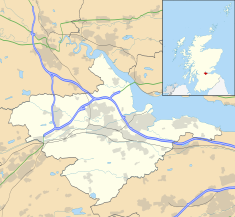| Airth Castle | |
|---|---|
 Airth Castle, seen from the south | |
| Coordinates | 56°03′41″N 3°46′17″W / 56.06131°N 3.77138°W |
Listed Building – Category A | |
| Designated | 25 October 1972 |
| Reference no. | 2102 |
Airth Castle is a castle overlooking the village of Airth and the River Forth, in the Falkirk area of Scotland. The castle is currently operated as a hotel and spa.
History
According to an account attributed Blind Harry, in 1298 a previous wooden fortification on this site was attacked by William Wallace, in order to rescue his imprisoned uncle, a priest from Dunipace. A later castle was destroyed after the defeat of King James III at Sauchieburn in 1488. The south west tower is the earliest part, dating to the period immediately thereafter. An extension was added on the east side in the mid 16th century.[1] Airth Castle was owned by the Bruces, Jacobite sympathizers who were forced to sell after the failure of the 1715 rebellion.
The castle is a major historic building, and retains much medieval fabric, and is designated as a Category A listed building by Historic Scotland.[2]
Within the castle grounds stand the ruins of the former parish church of Airth, a building, now roofless, of various periods, with substantial parts dating from the Romanesque period, and quire steeple and north aisle added by John Milne the royal master mason in 1647. [3] Access to the kirk is restricted for safety reasons. The graveyard includes a number of cast iron ‘mortsafes’, large coffin shaped containers used to thwart the plans of the body snatchers in the early 19th century.[4]
Ghosts
The castle is said to be haunted and reported phenomena include: Sightings of a nanny with two young children who are said to have died in a fire at the castle. The sound of children playing being heard in rooms 3, 4, 9 and 23. People have also reported hearing cries and screams believed to from a maid who was attacked by her master. Additionally a ghost dog, with a predilection for biting ankles, is believed to roam the hallways. [5] [6]
A groundsman reportedly haunts the lower floor of the castle.[7]
References
- ^ Scott, Ian. "Airth Castle", Falkirk Local History Society, 2006
- ^ "Listed Building Report". Historic Scotland. Retrieved 2009-09-11.
- ^ Contract June 1647 in National Archives of Scotland GD156/8
- ^ Scott, Ian. "Airth’s fascinating history written in stone", The Falkirk Herald, 28 June 2014
- ^ Ten of Scotland's most haunted hotels - Scotsman.com
- ^ BBC - Halloween happenings in your area
- ^ "Airth Castle's green phantom appears in wedding photo", Daily Record and Sunday Mail, 11 November 2013
